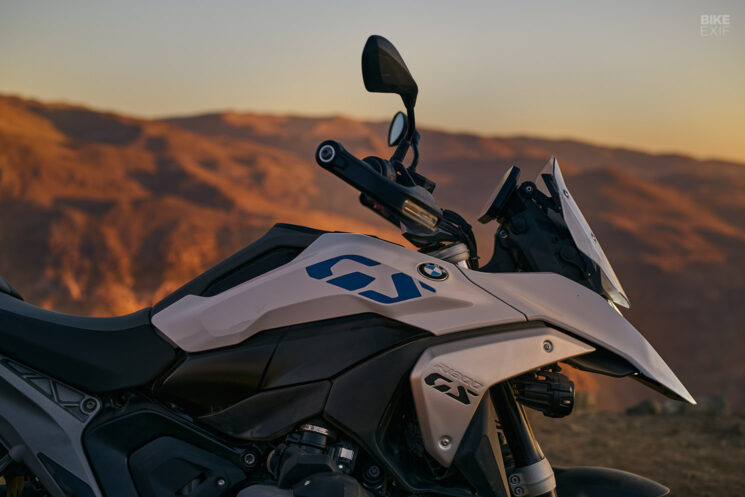
It’s been over a year since BMW Motorrad first hinted that a bigger version of its uber-popluar GS adventure bike was on its way. Now we finally have a proper look at the BMW R1300GS… and we’re not sure how we feel about it.
The adventure bike market’s been in full arms race mode for quite some time now, with major OEMs incrementally increasing engine capacity in a bid to stay on top. The outgoing R1250GS model squeezes a very respectable 136 hp and 143 Nm from its 1,254 cc boxer motor. But the market demands more.

The new BMW R1300GS has its engine capacity bumped to exactly 1,300 cc, now good for 145 hp at 7,750 rpm and 149 Nm at 6,500 rpm. The liquid-cooled motor is an all-new design, with the transmission now mounted under the engine, and an updated version of BMW’s ‘ShiftCam’ technology that varies valve timing on the intake side.
All this comes without a weight penalty. On the contrary, the R1300GS has actually shed 12 kilos [26.5 lbs], giving it a new curb weight of 237 kg [522.5 lbs]. The more compact engine is partly responsible, but so is the bike’s new chassis design.

BMW has once again employed their quirky Telelever front suspension design, and their traditional Paralever shaft-drive rear swingarm design, but both have been upgraded (they’re now called ‘EVO Telelever’ and ‘EVO Paralever). The front end uses a sheet metal shell-type frame made from steel, mated to a die-cast aluminum rear frame.
The GS still sports a 19F/17R wheel set, and 190/200 mm of travel front and rear, but the suspension now uses an updated version of the brand’s electronic DSA (Dynamic Suspension Adjustment) system. If you’re not familiar with it, DSA adjusts the front and rear damping on the fly—but the new system also adjusts the spring rate dynamically, based on road conditions, riding style, and whatever rider mode has been selected.

Optional extras include an adaptive ride-height adjustment system, and a ‘sports suspension’ package that adds 20 mm of travel at each end.
The rest of the new bike’s specs read like any flagship BMW. There’s a TFT display with a plethora of electronic riding aids and switchable modes, cruise control with a built-in radar system, collision and blind spot warning systems, a keyless ignition, and a Lithium-ion battery.

But the biggest talking point is the BMW R1300GS’s bold new look. No-one has ever accused the big GS of being svelte—but while this new iteration is still big-boned, it appears to be more streamlined than before. The redesigned plastics lack the muscular lines of the outgoing model, making for a smoothed-out design that looks bulbous from the front, forward-heavy from the side, and tapered towards the rear.
One major change is the R1300GS’s new X-shaped headlight. It’s a full-LED system, with different bits acting as daytime running lights, low beams, and high beams. Although the unit looks tiny, BMW promises that the new headlight “illuminates the road with a hitherto unrivalled clarity.”

It’s a radical departure from the blocky asymmetrical headlight design that the GS has sported for almost two decades. Does it look horrible? Not quite. Will it upset purists? Most likely.
The rest of the bike bears a few traditional GS hallmarks. The front beak is a familiar design, as are the silver panels that flank the fuel tank and the two-piece seat. The boxer motor is noticeably chunkier, and wears fewer cooling fins.

Your color choices are white, BMW’s awesome ‘Triple Black’ option, a ‘GS Trophy’ version that uses the marque’s signature blue, red, and white livery, and an ‘Option 719 Tramuntana’ version that uses metallic green paint and adds a host of machined parts. As usual, there’s an extensive category of aftermarket parts too.
The overall look of the new BMW R1300GS is sure to be polarizing. On the one hand, BMW were likely under pressure to break away from the chunky GS aesthetic that had become ubiquitous. On the other hand, the R1300GS feels like it’s trying so hard to be different, that it’s lost some of its magic.

The redesign also follows hot on the heels of the BMW F900GS’s striking new look, and comes days after BMW Motorrad announced that long-time head of design, Edgar Heinrich, is handing over the reins. Alexander Buckan will officially take over as Head of BMW Motorrad Design on the 1st of January, 2024, but he’s been at BMW since 2003.
In that time, he’s penned the BMW F800GS, G450X, R1200GS LC and R1200GS Adventure LC, and he’s most recently worked on the BMW CE04 and CE02 electric scooters.

He’s also the designer behind the redesign of the R1300GS, which begs the question: is this indicative of where BMW’s motorcycle design is heading? Only time will tell.
Source: BMW Motorrad
